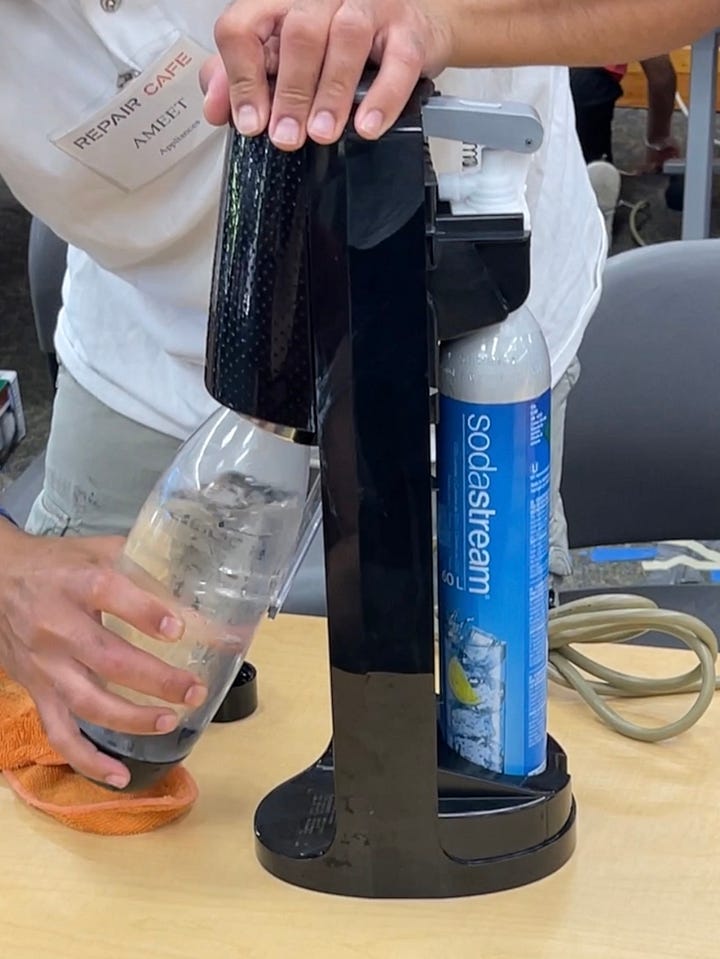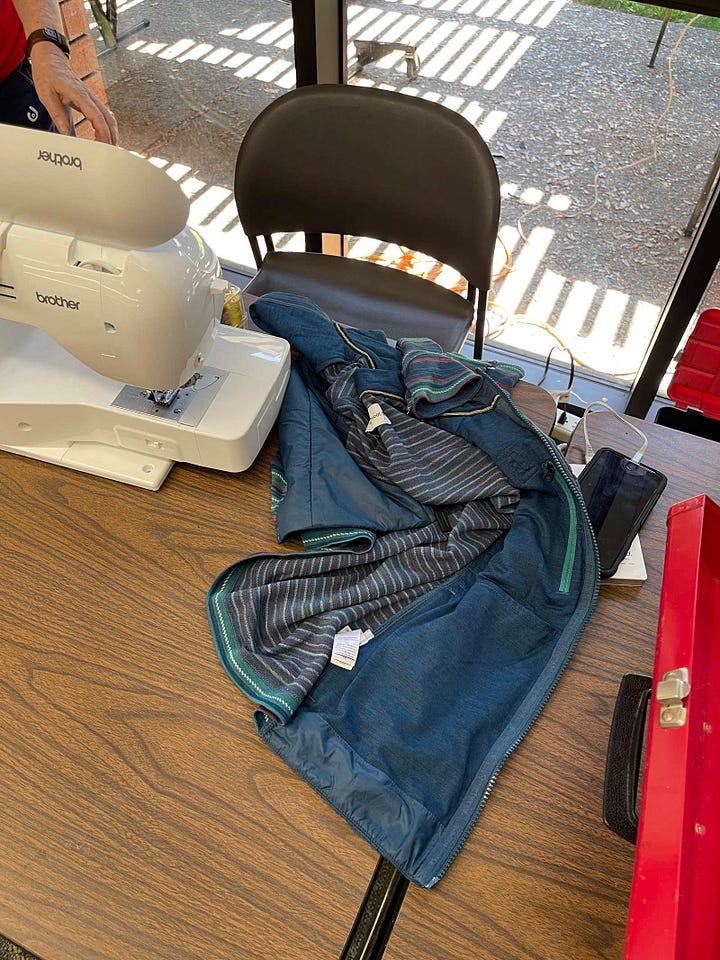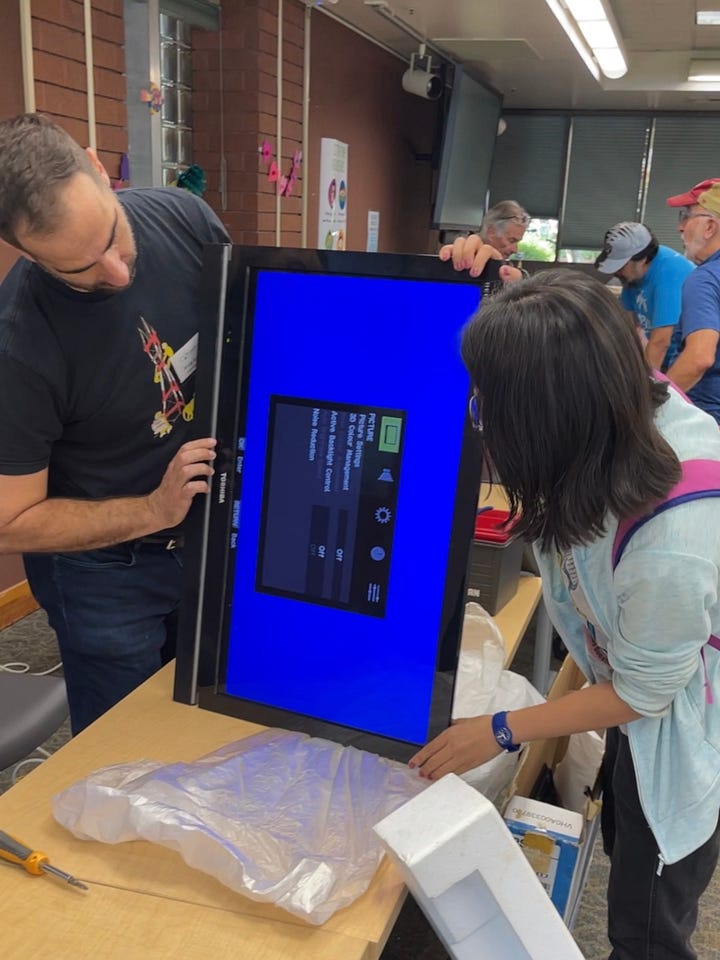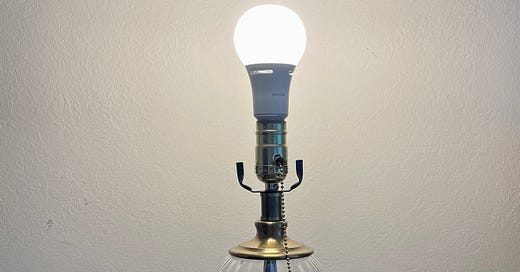After my bedside lamp broke, I couldn’t read in bed at night. I spend way too much time working in front of screens and cherish my time reading a physical book before I fall asleep. I really needed that lamp in working condition. My dad did teach me how to rewire a lamp when I was a teenager but I’ve forgotten how to do it, a repair café was coming up and besides, I needed material for this newsletter.
How repair cafés work
At our repair café in August, about 20 volunteer experts gathered at our local library to fix broken items—electronics, furniture, clothing, small appliances, bikes and so on. Clear bins filled with the materials necessary for a variety of repairs sat on tables in the back. The volunteers brought tools with them.
Rather than dropping an item off and returning to pick it up later as you would at a repair shop (if you can find one), at a repair café, you sit with the volunteer fixer, you explain the problem, you learn a bit about the repair process and you have a social interaction. In a long line, I waited with my lamp for the appropriate expert to call me. (If you attend a repair café, go early. The lines stretch out the door at ours.)
Every time a volunteer repaired an item, we'd hear a metal handbell ring. It rang several times during my lamp's straightforward fix—it needed a new socket and some tightening up of the base.
Extending the life of my lamp made me disproportionately happy. Or perhaps my happiness is appropriately proportional and advertising has it all wrong! Shiny new stuff doesn’t make you happy—mended old stuff does. I wasn’t alone. The repair café put everyone in a cheery, chatty mood. These kinds of events not only keep stuff out of landfill, they help build community.
Visit the Repair Café website to find a repair café near you or to learn how to start one. (The site appears in Dutch for me. Find the dropdown menu in the top right corner to choose English, French, German or Spanish.)




Library of things
Visitors who wanted to fix their items themselves (and knew how to do it) could use the equipment and supplies available during the repair café. Borrowing tools we only need occasionally rather than buying them saves money and reduces clutter.
Our library also lends all kinds of awesome tools, such as:
Auto repair tool kits
Induction cooktop kits
Serger or sewing machine kits
Power meters
Home repair tool kits
Gardening tool kits and yard carts
Baking equipment: cookie cutters, cake pans in all shapes, stand mixers
California state parks pass and hiking backpack kit
WiFi hotspots
Chromebooks
Search online for a tool lending library near you. Or ask about one in your Buy Nothing Group, your recycling center or your local library.
By the way, even if your library doesn’t lend tools, please visit it regardless and borrow some books. First, rightwing extremists come for the books. Then they come for the libraries.
If we want libraries to continue to exist, we better support them. And buy some banned books at your independent bookstore while you’re at it. Or order them from Bookshop.org, which supports bookstores, not billionaires.
The cost of not repairing stuff
My lamp did not cost much to buy. But the landfill doesn’t care whether we pay a lot or a little for the stuff we throw in it. Our five-year-old microwave (which we had not used much) also recently broke. The appliance repair technician I called to schedule a repair told me I should buy a new microwave because it will cost less than a repair. If I go by the metric of my bank account balance alone, I suppose that is true.
However, tossing the microwave (or the lamp) comes at a cost—the degradation of our life-sustaining environment in addition to a multi-billion-dollar, artificial system to deal with throwaway culture. This man-made system includes:
Million-dollar landfills (or incinerators costing hundreds of millions)
Heavy fossil-fuel burning trucks to haul away discarded resources
Heavy equipment and robots to sort the discarded resources
Staff to manage the trucks and the routes and the drivers
Staff to pick up discarded resources
Staff to manage the landfill (or incinerator)
And people have told me I’m extreme! But wait there’s more. Some trash travels long distances to other cities, states our countries that then must grapple with it. Landfills and nearby wells require monitoring of leachate, the toxic liquid that accumulates inside a landfill, generally from rainwater filtering through the trash heap. And just how much does the loss of land sacrificed for a landfill cost society? The manufacturer should pick up these external costs, especially if it designs its products to break down, forcing consumers to buy replacements (i.e., planned obsolescence is the business model).
Repair would create jobs and, unlike landfill space, we won’t run out of people to repair stuff—as long as we respect repair culture and train and pay people a decent wage to execute the repairs.
Right to repair laws coming to a state near you
By requiring manufacturers to make repair information, parts and tools available to the public and small businesses, right-to-repair laws enable consumers to either repair their electronics and equipment themselves or to farm that work out to third parties. These laws break the monopoly that manufacturers have had on repair and keep stuff out of the waste stream.
Thirty states have introduced varying right-to-repair bills this year. Last year, New York passed the Digital Fair Repair Act. This spring, Minnesota passed beefier legislation. California’s comprehensive Right to Repair Act, SB 244, gained the support of Apple, which long opposed legislation. The bill easily passed both the Assembly and Senate.
SB 244 requires manufacturers to provide the necessary parts, tools, and repair guides to a consumer or third-party repair shop upon request. If passed, SB 244 applies retroactively to consumer electronics and appliances dating back to 2021. This policy would be enforceable by the California Attorney General’s office, giving the state the power to penalize entities that are in violation of the act.
If you live in California, urge Governor Newsom to sign the right to repair bill into law.







“Extending the life of my lamp made me disproportionately happy.” I understand 💯!
Our community’s Council for the Aging has a fix-it shop, where senior volunteers fix your broken lamps, radios, etc for the price of any parts needed. It keeps the seniors busy and gives them a sense of worth in the community, as well as keeps things from going into the trash.